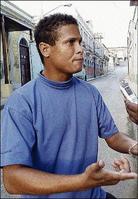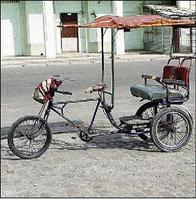Michelle-Ann Letman, Staff Reporter

A resident, who gave his name as Leo, speaks of infrastructural damage to his Santiago de Cuba home during the Atlantic hurricane season.
I can still feel my stomach churning and my head pounding, after suffering half-day journeys to and from Santiago de Cuba on the Jamaica Defence Force Coastguard's Middlesex vessel.
The ship transported hurricane relief items to northern neighbours, Cuba, which has so far sustained damage from four storms in 2008. Hurricane Ike dealt the island the biggest blow, kicking up storm surges five storeys high, adding to the trail of disaster from its antecedent, Gustav.
When I first heard of my assignment in Cuba, I was happy, anxious and excited, all at the same time. However, upon hearing that I would be travelling via boat, the idea of going to Cuba did not seem all that exciting.
My memory quickly flashed back to a couple of my journalism colleagues who, I heard, had nearly puked his organs out during a boat ride to the Pedro Cays.
Positive thoughts
I tried thinking positive thoughts. "It can't be that bad," I kept telling myself.
It was down to the wire, and the time to set sail was drawing near. I dragged myself to the vessel and got as comfortable as I could.
The clock struck eight, time to sail, but not before Lieutenant Commander Paul Wright laid down the rules.
I hugged my bag closely and braced for the ride.
"You sick already?" one crew member asked. He must have smelled the fear or noticed the queasiness in my face.
I pretended to be okay, but the coastguard wasn't buying it. They sat and waited to see if someone, more than likely a journalist, would bring up their dinner.
Surprisingly, it was one of their own who threw up.
I wasn't far from it, but pulled through, though I felt like someone had been hammering my head as the boat rattled, swaying from side to side.
I was literally dying to get to Cuba.
"Finally!" I shouted, as soon as we had docked in Cuba.
Though hardly a thrill-seeking adventurer, I opted to tour the city, along with another Jamaican journalist, on a bicycle taxi.
Costly decision
We soon realised it wasn't the best of ideas: For a ride that cost US$10, whenever we approached any synclines, we were forced to get off the bicycle and walk.
To make matters worse, some persons who decided to walk reached the city centre long before the taxi takers. We tried to convince the driver of the bicycle taxi to lower the fare, but to no avail.
Back to the boat we went, but not for long. After dinner, it was back to the streets of Santiago.
Buzzing with activity
By then, the roadways were buzzing with activity, all dressed to party; a reggaeton session was on the lips of everyone in town.
Time was against us, so the reggaeton party was not an option.
The park in the city's nucleus, which was earlier scanty, later became a romantic oasis, teeming with couples, listening to instrumental performances.
There were no couples amid our group, so the next best place to hang out was a bar.
A few Cuban beers and off we went to catch the last ferry.
Before we knew it, the day had passed and the crew was preparing to take to the seas, something I wasn't looking forward to.
michelle-ann.letman@gleanerjm.com
4 Fast Facts
1. The United States dollar is not legal tender; opt for the Canadian dollar or euro.
2. If you have US dollars, you can change them at any bank or cambio into pesos, the local currency.
3. It is not compulsory to receive a stamp in your passport when travelling from Jamaica.
4. Learn basic Spanish so you can find your way around the island.

The bicycle taxi is a popular mode of transport for Cubans and tourists in the southern city of Santiago de Cuba

Horse-drawn carriages add old-world charm to Santiago de Cuba. - Photos by Michelle-Ann Letman

